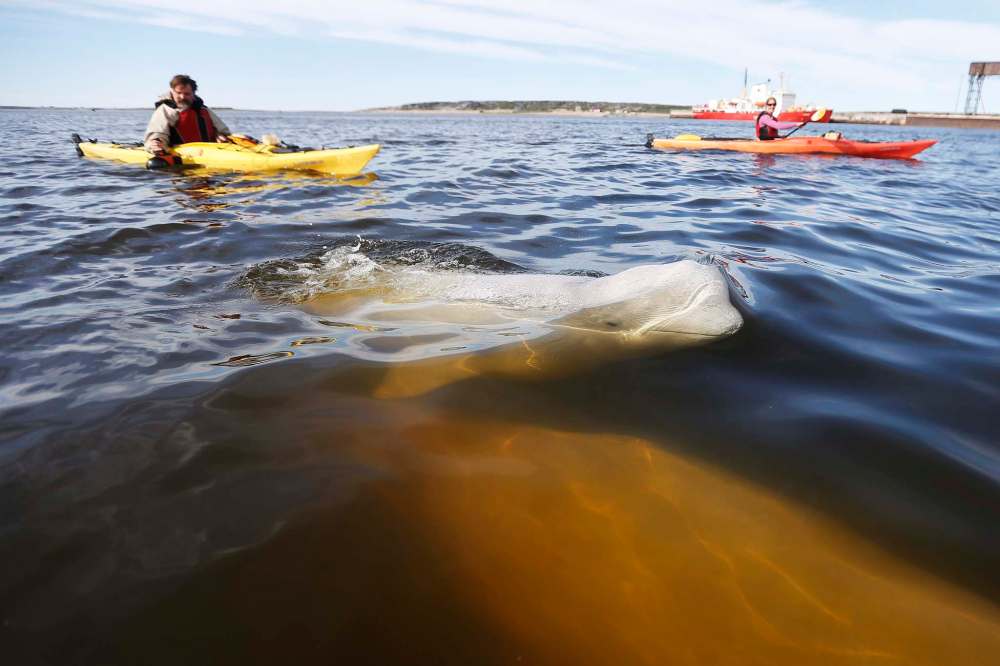Churchill takes your breath away
Whales in Manitoba? Yep, and polar bears too
Advertisement
Read this article for free:
or
Already have an account? Log in here »
To continue reading, please subscribe:
Monthly Digital Subscription
$1 per week for 24 weeks*
- Enjoy unlimited reading on winnipegfreepress.com
- Read the E-Edition, our digital replica newspaper
- Access News Break, our award-winning app
- Play interactive puzzles
*Billed as $4 plus GST every four weeks. Offer only available to new and qualified returning subscribers. Cancel any time.
Read unlimited articles for free today:
or
Already have an account? Log in here »
Hey there, time traveller!
This article was published 07/08/2021 (1305 days ago), so information in it may no longer be current.
With so many of us opting to explore Manitoba lately, I can’t help but reminisce about a summer visit to Churchill my son Carey and I took a few years back.
While I had taken various tourist tours in the past on visits to Mexico watching grey, blue and humpback whales, seeing the Belugas in Churchill was an entirely different experience.
What is the most dramatic contrast are their sheer numbers. Beluga whales are extremely social mammals. We did not have to race around the bays to look for them — they found us.

About 57,000 of these magnificent creatures journey to Hudson’s Bay every summer, with more than 4,000 of them that move into the Churchill River Estuary.
To find ourselves in the centre of a pod of 50 or more was not unusual. We were excited at the sight of the first Beluga. That excitement grew into an almost eerie sense of delirium as their numbers kept multiplying around us. At one point, I felt a sense of serenity, marvelling at these wonders of nature who made me wonder about the wet world which they inhabit, which may be even more fascinating than the sights and sounds above.
We could constantly see their forms below the surface, with a few teasing us as they came above the waters to take a breath — letting us know on those rare moments when they seemed to disappear — they were still there.
And there is truly much more to see on an excursion to Churchill. We had previously taken the opportunity to visit Churchill in winter to see the polar bears — a totally unique experience unto itself; but a summer visit is in many ways as enjoyable and informing as a winter visit.
The Tundra Buggy, the giant vehicle, which takes visitors to see the bears, is worth climbing aboard for a tour along the shoreline along and over the tundra which identifies the entire surrounding area. We spotted a number of smaller animals and appreciated walking along the shoreline where the grizzlies are soon to inhabit. We were not lucky enough on that occasion to spot any early arrivers as others have done.
For a few minutes we even took the opportunity to drive this Manitoba designed people moving machine, which is its own tourist attraction. It was created to keep visitors high above the ground for their protection— while ensure no one can interfere with the delicate lives of the bears who must not get too used to human interactions.
We travelled with Frontiers North on both our summer and winter adventures, and both trips were absolutely perfect.
Fort Prince of Wales was built to protect the Hudson’s Bay Fur trade from being invaded by the French. It was not successful in doing so, when in the 1780s it was overtaken by a large French contingent — who subsequently destroyed much of it.
Fortunately, it was mainly constructed of stone and still remains as a National Historic Site — a truly worthwhile visit. From the fort we could view the waters from which the French likely chose to land and attack the ill-manned fortress.
This region has been inhabited with peoples who lived here from at least 3000 BC. In the Itsanitag Museum we found collections of Inuit art, carvings and artifacts that are among the finest and oldest in the world dating from Pre-Dorset (1700 BC) through Dorset Thule and modern Inuit times.
As a shipping centre, Churchill has seen many ups and downs over the decades — but its massive inland terminal really is a sight to see. Built for grain exports, it started shipping to countries around the world in 1931. Its short season, rail and other challenges have prevented it from reaching its potential. Many believe its best days are still yet to come.
pradinukr@shaw.ca

Ron Pradinuk
Travel writer
A writer and a podcaster, Ron's travel column appears in the Winnipeg Free Press every Saturday in the Destinations and Diversions section.
Our newsroom depends on a growing audience of readers to power our journalism. If you are not a paid reader, please consider becoming a subscriber.
Our newsroom depends on its audience of readers to power our journalism. Thank you for your support.


